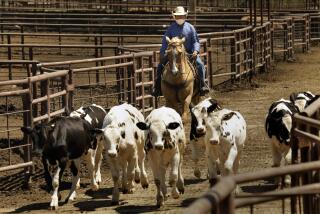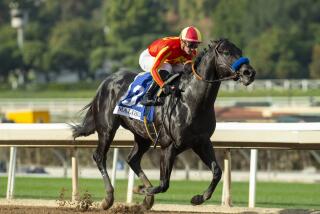‘Moneyball for cattle’: How analytics are creating an American steak renaissance
- Share via
Reliance is a black Angus bull with a long, fluid stride. He has a quiet confidence when he walks. It’s one of the qualities that led cattlemen to bid up the prized animal to $150,000 during a recent bull sale at Woodhill Farms in Viroqua, Wis.
But there’s more to Reliance than his poise. He comes with a printout of genomic assessments and a family tree going back generations. The numbers say he’s a winner, and these days, the numbers are right. He’s rated in the top 3% of all Angus bulls for ribeye quality, and the top 5% for marbling — the white, fatty flecks that make beef more flavorful and tender, according to Brian McCulloh, who bred the “big-money bull.”
Reliance’s descendants are almost guaranteed to turn into delectable Porterhouses, which their owners can charge more money for accordingly.
Today, cattlemen can pick out superior calves better than they ever have, as DNA testing gets cheaper and projections get more accurate. That’s transforming the beef industry, with cattle that make high-end beef becoming the vast majority of U.S. herds in recent years. Lower-quality beef is forecast to all but vanish from the U.S. market, while the highest quality, once a rarity, is common enough that retailers such as Costco Wholesale Corp. stock it.
“It’s like moneyball for cattle,” Mark McCully, vice president of production for Certified Angus Beef, said of the advanced statistics movement. “Back in the day, the eye of the stockman was all we had, and now we have high-powered analytical tools and can make progress so much faster.”
More marbled beef has driven down prices. USDA prime beef was selling for $2.2458 a pound wholesale last year, the lowest since 2011. That compares with $2.0106 a pound for USDA select beef, which has little marbling.
Now choice cuts once found only at white-tablecloth steakhouses are available at the local grocery store. There’s so much elite beef sloshing around these days, companies have taken to slapping fancy names on their products. There are 95 U.S.-government-certified beef brands today. Tyson Foods sells Chairman’s Reserve and Open Prairie Natural Angus beef; JBS SA has 5 Star Reserve and 1855 Black Angus beef. The democratization of steak has even reached Walmart, which upgraded to certified Angus steaks in 2017.
One breed is dominant when it comes to the quantitative genetics game: the hornless, black Angus, which has been promoted as having better beef than others. When new calves are born, they’re registered with the American Angus Assn., and their pedigrees are confirmed with DNA testing, which costs about $37 a test, compared with $139 in 2011.
A host of measurements are taken and compared against databases that can include millions of animals. So much data has been collected at this point that the statistical modeling has become startlingly accurate, said Dan Moser, president of the nonprofit Angus Genetics Inc.
The gains from that data, once applied to breeding, are like compound interest. Last year, 82% of the U.S. herd was comprised of the two highest-quality beef categories — USDA prime and choice, McCully said. Just five years ago, only 70% of the herd qualified. Prime, considered the most desirable of meats, was for decades just a percent or two of the herd. Now it’s around 10%.
The profusion of marbled meat and a strong economy are helping drive a beef renaissance, said Shane Miller, senior vice president of beef enterprise at Tyson Food Inc. American consumers, now accustomed to ribeyes over lesser cuts, will eat 57.7 pounds of beef per capita this year, the highest in almost a decade, according to government data.
If a man and wife, they go to a steakhouse and lay down $100 to eat and have a bad eating experience, they’re not coming back for a while.
— Jim Moore, third-generation rancher
In the past, such luxury beef was a happy accident. More often than not, cattlemen chose a bull because they liked the look of it. They watched the way it walked, preferring animals with long strides, because those that took short and choppy steps don’t gain weight as well. They’d release bulls into the pastures with the females and only years later when the offspring were grown, fattened up and sent to market could a farmer know if he had made the right call.
This started to change in the 1970s and 1980s, when a few revolutionary tools quietly came into being. The American Angus Assn. had long been registering animals and collecting data on everything from how easily a calf was born to how docile it was. But in the 1970s the industry began using statistical models to predict how good an animal was as a parent and the probability that it would transmit any prized traits to its children. The forecasts helped. By the 1990s, these ratings — called expected progeny differences, or EPDs — had become the premier tool for American cattlemen who wanted to make better beef.
By 1990 the industry also started using ultrasounds to see what the meat of a live bull looked like. With that, breeders could immediately know whether a bull had the good-meat genes it was supposed to pass on. “Previously, you had to sacrifice the animal to get that data,” Moser said.
That all led to huge gains in the herd’s quality. By 2010 another leap had come. Early adopters started testing the DNA of bull calves, or genotyping them, which lets breeders quickly identify superior young animals. DNA is extracted from blood, hair or tissue samples and put onto a chip and run through a machine that looks at approximately 55,000 positions in the DNA. (An early developer of such DNA chips, also called microarrays, incidentally, is Pat Brown, CEO of Impossible Foods, who wants his meatless burger to eliminate the need for traditional beef.) That’s translated into information used for calculating breeding values, or the value of the genes that an animal transmits to its children.
Some of the most innovative work is being done at the University of Georgia in Athens, which has had a large agricultural research operation since the 19th century. In a third-floor office space, where two rooms are crammed with data-crunching computers, Daniela Lourenco and her colleagues are sharpening the accuracy of methods originally developed a decade ago by U.S. Department of Agriculture researchers and first applied to Holstein dairy cows in the U.S. Lourenco, a 37-year-old assistant professor of animal breeding and genetics from Brazil, spends her days trying to more efficiently translate the effects of genes into a number based on the DNA information from millions of animals. The more accurate that number, the better she can identify the best animals, from cattle and pigs to chickens and honey bees.
“I always joke that I’m very proud when I eat a good steak, especially from Angus, because I know most likely it’s the progeny of an animal that was selected based on our software method,” she said. Lourenco added that breeding genetics is helping with food security, as the world will have to feed 9 to 10 billion people in the coming decades. “I’m very excited that we can bring a better way to identify the best animals and to help improve animal production.”
Though some ranchers are reluctant to embrace data-driven breeding — it’s not the cowboy way — Jim Moore has jumped in with both feet. A third-generation rancher who runs about 300 cattle in Charleston, Ark., Moore began trying to increase the marbling of his herd 25 years ago. Previously, ranchers had no economic incentive to do so because cattle were sold on a per-pound basis and fetched the same prices whether they were well-marbled or not. But in the mid 1990s, slaughter plants began paying up for quality.
Fifteen or so years ago, about half of Moore’s herd rated choice and prime — about the national average at the time. Today, thanks to DNA testing and moneyball scores, all of his animals fall into the top categories for marbled beef, with as many as 53% of them making the top grade. “We started making gradual progression,” he said. “Then all at once it started clicking.”
If DNA tests show heifers, or young females, lack the ability to marble, Moore gets rid of them. The keepers are mated with bulls with high marbling scores. The resulting calves are raised until they’re about a year old and between 700 and 800 pounds. Then they’re trucked to a feedlot in Kansas, where they stay for 160 to 190 days until they reach 1,400 pounds or more. The animals go to a National Beef Co. packing plant in Dodge City, Kan., and Moore is paid at that point for each animal, based on quality. The meat is then marketed through U.S. Premium Beef, which has a slew of brands including Certified Angus Beef.
“We’re passionate about the fact that we have to produce as high quality beef as we can possibly produce,” Moore said. “If a man and wife, they go to a steakhouse and lay down $100 to eat and have a bad eating experience, they’re not coming back for a while. If it’s juicy and tender and prepared well, they’re a lot more apt to come back.”
Science and math have transformed the steak industry in less than a generation. But successful ranchers also know that a happy animal is equally crucial to creating delicious beef.
On his Arkansas acreage, Moore does whatever it takes to give cattle the best shot at making the grade. That includes feeding them well, making sure they go to the vet and always handling them gently. “We keep them as calm as we can possibly can,” he said.
More to Read
Inside the business of entertainment
The Wide Shot brings you news, analysis and insights on everything from streaming wars to production — and what it all means for the future.
You may occasionally receive promotional content from the Los Angeles Times.










